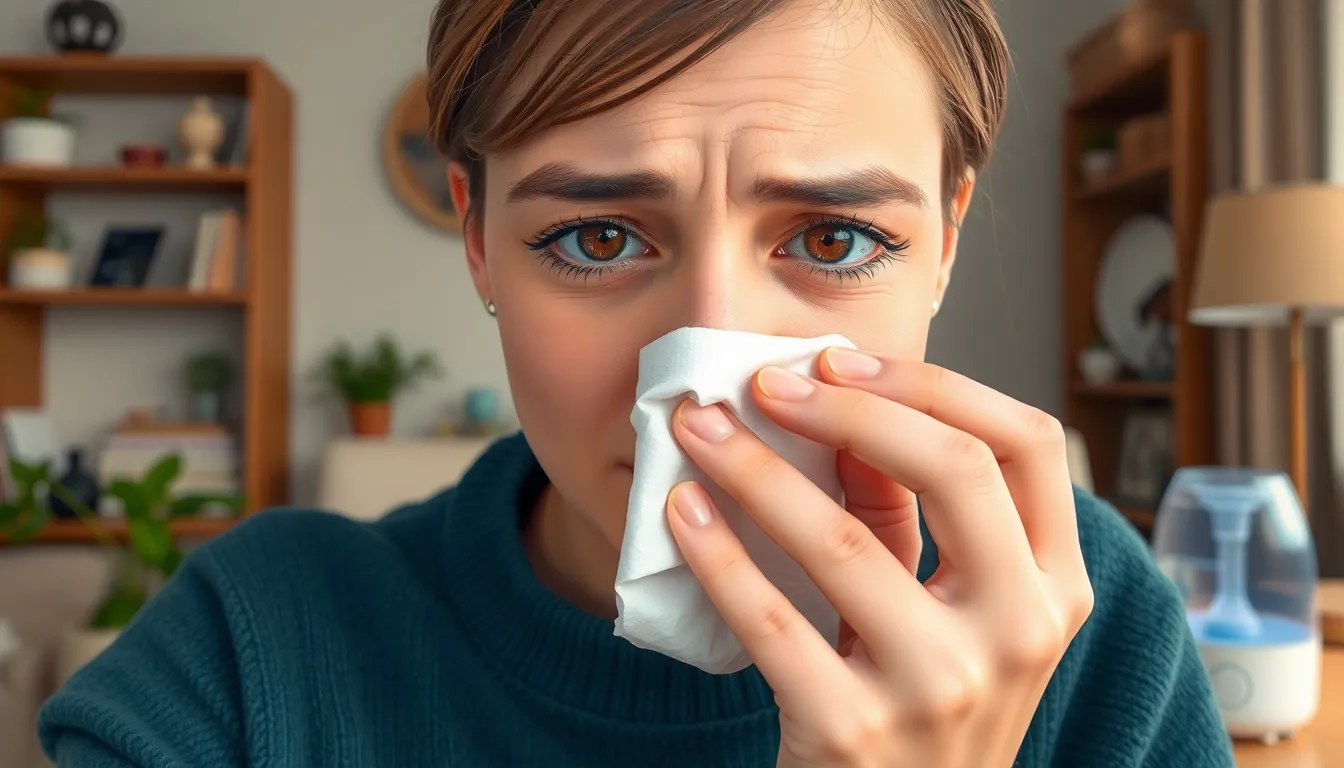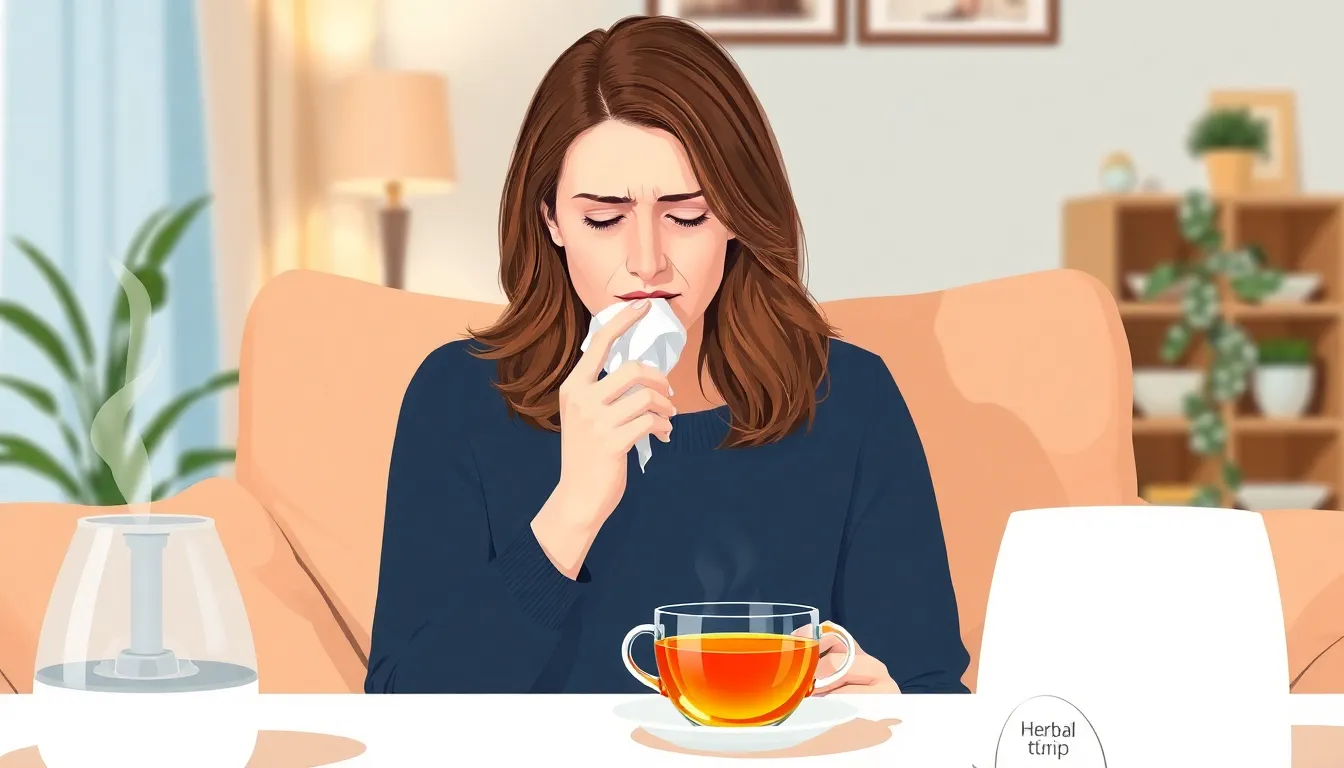Post nasal drip can feel like an unwelcome guest who just won’t leave the party. It sneaks in, causing discomfort and that annoying tickle in the throat that makes anyone sound like a croaky frog. If you’ve ever found yourself reaching for tissues more than your favorite snacks, you know how frustrating it can be.
Table of Contents
ToggleUnderstanding Post Nasal Drip
Post nasal drip occurs when excess mucus builds up in the throat and nasal passages. This condition irritates the throat, leading to uncomfortable symptoms.
What Is Post Nasal Drip?
Post nasal drip refers to the accumulation of mucus that drips down the back of the throat. Nasal passages produce mucus to trap pathogens and allergens. When mucus becomes thick or excessive, it can lead to a feeling of congestion and discomfort. Conditions such as allergies, colds, or sinus infections often trigger this irritation.
Symptoms of Post Nasal Drip
Symptoms of post nasal drip vary and can affect daily life. Common symptoms include a persistent cough, sore throat, and a sensation of mucus in the throat. Some individuals experience bad breath and difficulty swallowing. Additional signs could manifest as a runny or congested nose, especially noticeable in the morning. Identifying symptoms aids in determining the necessity of relief measures.
Causes of Post Nasal Drip

Multiple factors contribute to post nasal drip, each leading to the accumulation of excess mucus in the throat and nasal passages.
Allergies
Allergic reactions often trigger post nasal drip. Pollen, dust mites, and pet dander can cause the body to produce more mucus. Symptoms may include sneezing, a runny nose, and itchy eyes. Identifying allergy triggers is crucial for managing symptoms. Over-the-counter antihistamines can help alleviate discomfort caused by these allergens. Avoiding exposure to known allergens also lessens the likelihood of post nasal drip episodes.
Infections
Infections significantly contribute to the development of post nasal drip. Viral infections, like the common cold, lead to increased mucus production. Sinus infections also cause inflammation and excess mucus, resulting in discomfort. Symptoms of infections include cough, sore throat, and facial pain. Treating the underlying infection efficiently reduces mucus buildup. Prescription medications may be necessary in severe cases to clear up persistent infections.
Environmental Factors
Environmental factors influence the severity of post nasal drip. Dry air, smoking, and exposure to strong odors can irritate the nasal passages. Humidity levels play a key role; high humidity may worsen mucus production while low humidity can dry out the throat. Recognizing these environmental factors supports effective management. Using humidifiers may relieve symptoms in dry conditions, while avoiding irritants helps minimize discomfort.
Home Remedies for Post Nasal Drip
Home remedies can effectively alleviate the symptoms of post nasal drip. These methods offer convenience and accessibility for managing discomfort.
Hydration
Staying hydrated plays a crucial role in thinning mucus. Drinking plenty of water, herbal teas, or clear broths helps maintain fluid balance. Warm beverages, especially those with honey or lemon, provide added soothing effects. Keeping hydrated reduces the viscosity of mucus, making it easier to expel. Aim for at least eight 8-ounce glasses of fluids daily to enhance overall wellness.
Steam Inhalation
Steam inhalation promotes relief by moisturizing nasal passages. Breathing in steam from hot water or a shower soothes irritated tissues in the throat and nasal areas. Adding essential oils like eucalyptus or peppermint can enhance the experience, providing extra nasal decongestion. Regular sessions can help reduce the thickness of mucus, making breathing easier. Just ten minutes of steam inhalation several times a day offers significant comfort.
Saline Nasal Rinse
Saline nasal rinses provide effective relief by flushing out excess mucus and allergens. Using a neti pot or saline spray can help clear the nasal passages. This process reduces inflammation, which contributes to post nasal drip symptoms. Performing a rinse once or twice daily can significantly improve comfort. Ensuring the saline solution is isotonic promotes safety and effectiveness.
Over-the-Counter Treatments
Over-the-counter treatments offer quick relief for post nasal drip symptoms. Several options can help ease discomfort and improve overall well-being.
Antihistamines
Antihistamines reduce mucus production caused by allergies. Options like diphenhydramine and loratadine block histamine’s effects, providing symptom relief. They help ease a runny nose and sneezing. Drowsiness may accompany some older antihistamines, but non-drowsy alternatives are available. He or she can consult with a pharmacist to find the best choice based on individual needs.
Decongestants
Decongestants work by narrowing blood vessels in nasal passages, reducing swelling. Medications such as pseudoephedrine effectively increase airflow and decrease congestion. Nasal sprays containing oxymetazoline provide quicker relief for blocked nasal passages. It’s essential to use these sprays as directed, since overuse can lead to rebound congestion. Combining these treatments with hydration ensures optimal results.
Nasal Sprays
Nasal sprays target specific symptoms of post nasal drip. Saline sprays moisturize nasal passages and help flush out unwanted mucus. Corticosteroid sprays, like fluticasone, reduce inflammation and provide longer-term relief. Use these options daily for sustained benefits. Each spray serves a unique purpose and can significantly improve comfort when used correctly.
When to Seek Medical Help
Recognizing when to seek medical help for post nasal drip can prevent complications. Some symptoms may require professional evaluation to rule out serious conditions.
Warning Signs
Persistent symptoms indicate a potential need for medical assistance. If a cough lasts more than three weeks or worsens, consulting a healthcare provider is essential. Severe throat pain accompanied by difficulty swallowing warrants immediate attention. High fever exceeding 101°F may signal an infection that requires treatment. If symptoms include shortness of breath or wheezing, prompt medical care is necessary. Unexplained nasal discharge that persists beyond a week, especially if it appears green or bloody, should also raise concern.
Professional Treatments
Healthcare professionals may recommend various treatments for persistent post nasal drip. Prescription antihistamines can target underlying allergies more effectively than over-the-counter options. Infections may require antibiotic therapy if bacterial in nature. Nasal corticosteroids can significantly reduce inflammation in the nasal passages, providing relief from symptoms. Immunotherapy, such as allergy shots, offers a long-term solution for those with severe allergic reactions. Lastly, consultations for imaging studies may help identify issues like sinus blockages or structural abnormalities, guiding appropriate intervention.
Finding relief from post nasal drip is essential for improving comfort and quality of life. By identifying triggers and symptoms, individuals can take proactive steps to manage their condition effectively. Home remedies like staying hydrated and using steam inhalation can provide significant relief. Over-the-counter treatments offer additional options for those seeking quick solutions.
It’s crucial to remain vigilant about symptoms and know when to seek medical advice. With the right approach and awareness, anyone can tackle post nasal drip and reclaim their well-being.





